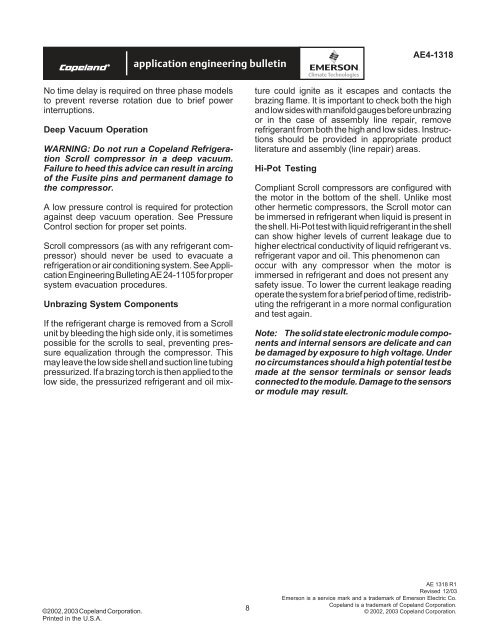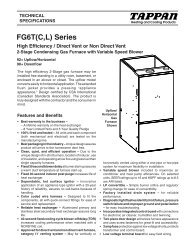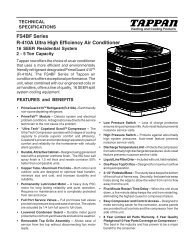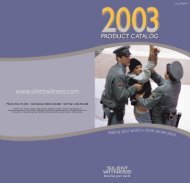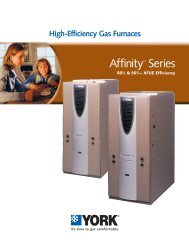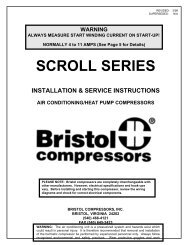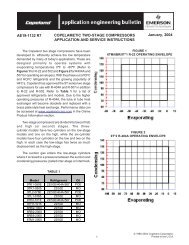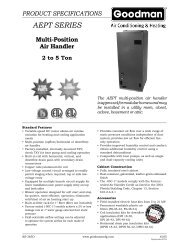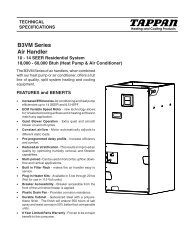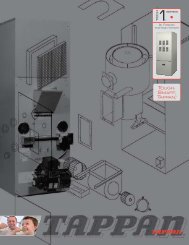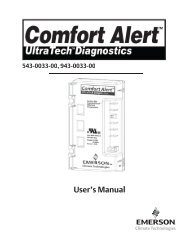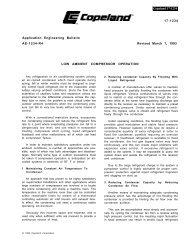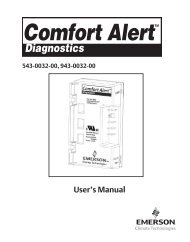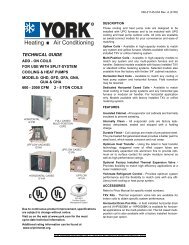Scroll Compressor Application Guidelines - Desco Energy
Scroll Compressor Application Guidelines - Desco Energy
Scroll Compressor Application Guidelines - Desco Energy
- No tags were found...
Create successful ePaper yourself
Turn your PDF publications into a flip-book with our unique Google optimized e-Paper software.
AE4-1318No time delay is required on three phase modelsto prevent reverse rotation due to brief powerinterruptions.Deep Vacuum OperationWARNING: Do not run a Copeland Refrigeration<strong>Scroll</strong> compressor in a deep vacuum.Failure to heed this advice can result in arcingof the Fusite pins and permanent damage tothe compressor.A low pressure control is required for protectionagainst deep vacuum operation. See PressureControl section for proper set points.<strong>Scroll</strong> compressors (as with any refrigerant compressor)should never be used to evacuate arefrigeration or air conditioning system. See <strong>Application</strong>Engineering Bulleting AE 24-1105 for propersystem evacuation procedures.Unbrazing System ComponentsIf the refrigerant charge is removed from a <strong>Scroll</strong>unit by bleeding the high side only, it is sometimespossible for the scrolls to seal, preventing pressureequalization through the compressor. Thismay leave the low side shell and suction line tubingpressurized. If a brazing torch is then applied to thelow side, the pressurized refrigerant and oil mixturecould ignite as it escapes and contacts thebrazing flame. It is important to check both the highand low sides with manifold gauges before unbrazingor in the case of assembly line repair, removerefrigerant from both the high and low sides. Instructionsshould be provided in appropriate productliterature and assembly (line repair) areas.Hi-Pot TestingCompliant <strong>Scroll</strong> compressors are configured withthe motor in the bottom of the shell. Unlike mostother hermetic compressors, the <strong>Scroll</strong> motor canbe immersed in refrigerant when liquid is present inthe shell. Hi-Pot test with liquid refrigerant in the shellcan show higher levels of current leakage due tohigher electrical conductivity of liquid refrigerant vs.refrigerant vapor and oil. This phenomenon canoccur with any compressor when the motor isimmersed in refrigerant and does not present anysafety issue. To lower the current leakage readingoperate the system for a brief period of time, redistributingthe refrigerant in a more normal configurationand test again.Note: The solid state electronic module componentsand internal sensors are delicate and canbe damaged by exposure to high voltage. Underno circumstances should a high potential test bemade at the sensor terminals or sensor leadsconnected to the module. Damage to the sensorsor module may result.©2002, 2003 Copeland Corporation.Printed in the U.S.A.8AE 1318 R1Revised 12/03Emerson is a service mark and a trademark of Emerson Electric Co.Copeland is a trademark of Copeland Corporation.© 2002, 2003 Copeland Corporation.


